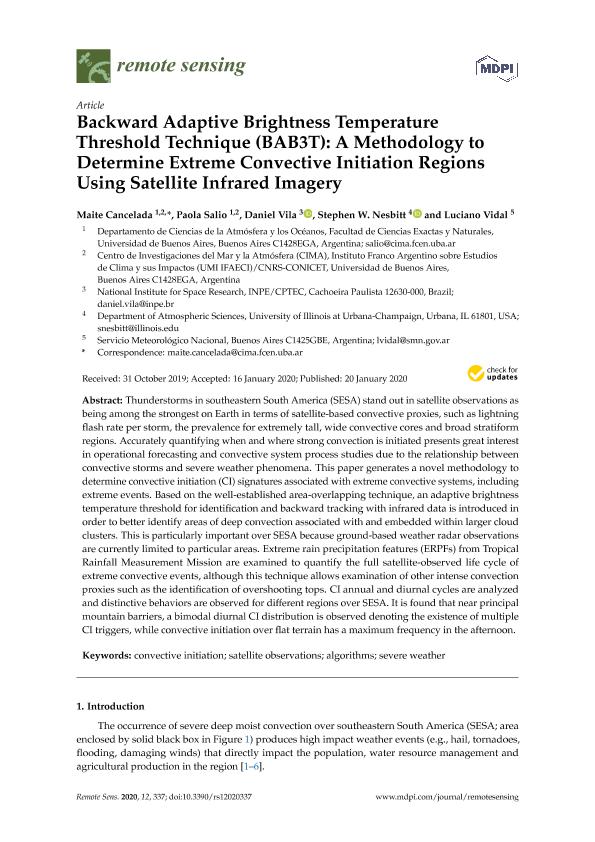Mostrar el registro sencillo del ítem
dc.contributor.author
Cancelada, Maite

dc.contributor.author
Salio, Paola Veronica

dc.contributor.author
Vila, Daniel
dc.contributor.author
Nesbitt, Stephen William

dc.contributor.author
Vidal, Luciano

dc.date.available
2021-10-18T17:13:50Z
dc.date.issued
2020-01
dc.identifier.citation
Cancelada, Maite; Salio, Paola Veronica; Vila, Daniel; Nesbitt, Stephen William; Vidal, Luciano; Backward adaptive brightness temperature threshold technique (BAB3T): A methodology to determine extreme convective initiation regions using satellite infrared imagery; Molecular Diversity Preservation International; Remote Sensing; 12; 2; 1-2020; 1-19
dc.identifier.issn
2072-4292
dc.identifier.uri
http://hdl.handle.net/11336/144124
dc.description.abstract
Thunderstorms in southeastern South America (SESA) stand out in satellite observations as being among the strongest on Earth in terms of satellite-based convective proxies, such as lightning flash rate per storm, the prevalence for extremely tall, wide convective cores and broad stratiform regions. Accurately quantifying when and where strong convection is initiated presents great interest in operational forecasting and convective system process studies due to the relationship between convective storms and severe weather phenomena. This paper generates a novel methodology to determine convective initiation (CI) signatures associated with extreme convective systems, including extreme events. Based on the well-established area-overlapping technique, an adaptive brightness temperature threshold for identification and backward tracking with infrared data is introduced in order to better identify areas of deep convection associated with and embedded within larger cloud clusters. This is particularly important over SESA because ground-based weather radar observations are currently limited to particular areas. Extreme rain precipitation features (ERPFs) from Tropical Rainfall Measurement Mission are examined to quantify the full satellite-observed life cycle of extreme convective events, although this technique allows examination of other intense convection proxies such as the identification of overshooting tops. CI annual and diurnal cycles are analyzed and distinctive behaviors are observed for different regions over SESA. It is found that near principal mountain barriers, a bimodal diurnal CI distribution is observed denoting the existence of multiple CI triggers, while convective initiation over flat terrain has a maximum frequency in the afternoon.
dc.format
application/pdf
dc.language.iso
eng
dc.publisher
Molecular Diversity Preservation International

dc.rights
info:eu-repo/semantics/openAccess
dc.rights.uri
https://creativecommons.org/licenses/by-nc-sa/2.5/ar/
dc.subject
ALGORITHMS
dc.subject
CONVECTIVE INITIATION
dc.subject
SATELLITE OBSERVATIONS
dc.subject
SEVERE WEATHER
dc.subject.classification
Meteorología y Ciencias Atmosféricas

dc.subject.classification
Ciencias de la Tierra y relacionadas con el Medio Ambiente

dc.subject.classification
CIENCIAS NATURALES Y EXACTAS

dc.title
Backward adaptive brightness temperature threshold technique (BAB3T): A methodology to determine extreme convective initiation regions using satellite infrared imagery
dc.type
info:eu-repo/semantics/article
dc.type
info:ar-repo/semantics/artículo
dc.type
info:eu-repo/semantics/publishedVersion
dc.date.updated
2021-09-07T18:14:46Z
dc.journal.volume
12
dc.journal.number
2
dc.journal.pagination
1-19
dc.journal.pais
Suiza

dc.journal.ciudad
Basel
dc.description.fil
Fil: Cancelada, Maite. Consejo Nacional de Investigaciones Científicas y Técnicas. Oficina de Coordinación Administrativa Ciudad Universitaria. Centro de Investigaciones del Mar y la Atmósfera. Universidad de Buenos Aires. Facultad de Ciencias Exactas y Naturales. Centro de Investigaciones del Mar y la Atmósfera; Argentina
dc.description.fil
Fil: Salio, Paola Veronica. Consejo Nacional de Investigaciones Científicas y Técnicas. Oficina de Coordinación Administrativa Ciudad Universitaria. Centro de Investigaciones del Mar y la Atmósfera. Universidad de Buenos Aires. Facultad de Ciencias Exactas y Naturales. Centro de Investigaciones del Mar y la Atmósfera; Argentina
dc.description.fil
Fil: Vila, Daniel. National Institute for Space Research; Brasil
dc.description.fil
Fil: Nesbitt, Stephen William. University of Illinois at Urbana; Estados Unidos
dc.description.fil
Fil: Vidal, Luciano. Ministerio de Defensa. Secretaria de Planeamiento. Servicio Meteorológico Nacional; Argentina. Consejo Nacional de Investigaciones Científicas y Técnicas; Argentina
dc.journal.title
Remote Sensing
dc.relation.alternativeid
info:eu-repo/semantics/altIdentifier/url/https://www.mdpi.com/2072-4292/12/2/337
dc.relation.alternativeid
info:eu-repo/semantics/altIdentifier/doi/http://dx.doi.org/10.3390/rs12020337
Archivos asociados
